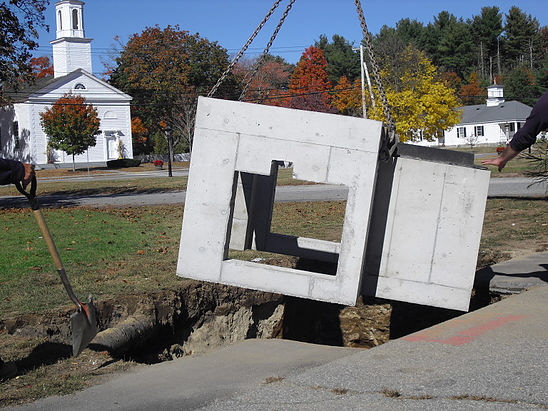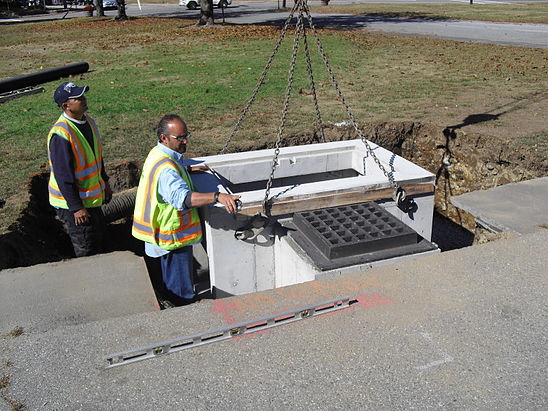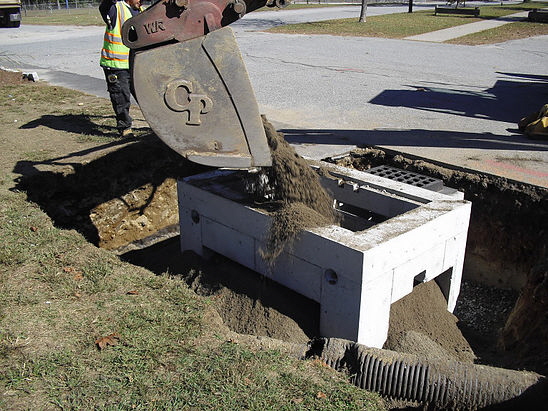|
 Northern Rhode Island Conservation Committee Northern Rhode Island Conservation Committee
Filtering Stormwater with Trees: A Case Study
(Ecological Landscape Alliance)
April 25, 2016 | Sandra Tremblay
Last fall, StormTree in partnership with the Northern Rhode Island Conservation District (NRICD) completed the installation of three tree filter systems for stormwater management on the North Scituate village green, the home of the Scituate Art Festival, which draws an annual attendance of close to 100,000 during each Columbus Day weekend. The North Scituate village green is located less than 500 feet from the watershed associated with the Scituate Reservoir. Construction of the nearly six-mile-long Scituate Reservoir began in 1915 and is the largest fresh water body in Rhode Island providing a water supply to 60% of the state’s population.
The NRICD received a state grant to develop and install bioretention systems as part of a non-point source pollution reduction program to mitigate nutrient loading from nitrogen, phosphorus, and other pollutants entering the reservoir’s watershed. Bioretention is the process in which contaminants and sedimentation are removed from stormwater runoff. Under the program, a variety of stormwater management practices were initiated in North Scituate village over the course of two years. In the first phase of the project, the NRICD identified seven homes and small business owners who were open to having small stormwater management practices like rain gardens (small, landscaped depressions that hold stormwater after it rains) installed on their properties.
Phase 2: Tree Filters
Rhode Island-based StormTree was contracted to install tree filter systems on the village green as part of the second and final phase of the pollution mitigation plan to protect the Scituate River watershed. The StormTree system integrates common landscape trees with stormwater runoff collection and pollutant treatment. Tree filters are an important tool in the arsenal of best management practices (BMPs) for stormwater management by watershed districts, as well as the landscape architects and engineers.
Tree filters utilize an “engineered” soil media to absorb and treat stormwater through a variety of physical, chemical, and biological processes, with combined high infiltration and water holding capacity. This balance allows for healthy tree growth and substantial rainwater runoff collection and treatment. The media filters pollutants such as phosphorus and nitrogen, which are generated from sources like dog waste and fertilizer, from stormwater runoff. The StormTree system consists of an open bottomed and open sided precast concrete frame which contains the media. Since the precast frame is open sided, it permits the filter media to expand beyond the footprint of the frame. This expansion allows for a greater filter area, and most importantly, ensures that tree roots are not confined or restricted. While the tree beautifies the neighborhood, it also benefits from greater quantities of water due to the stormwater collection. An attached catch basin or sump collects sands and sediments and provides ease of maintenance.
 |
 |
 |
Additional challenges for StormTree were alleviating safety concerns based on the location of the systems within a heavily (pedestrian) trafficked area. Also, in the absence of curbing, it was important to protect the front of the concrete structures, particularly during winter snow plowing. On the front side of the system which faced either parking lots or an access road, concrete bollards were installed to protect the systems from plow damage.
In keeping with the NRICD’s goal of encouraging the planting of native species, Amelanchier (serviceberry), in tree form, was selected for the tree filters. The species, Amelanchier × grandiflora ‘Autumn Brilliance,’ which is prized for its sturdy growth and brilliant orange-red fall color, was locally sourced and 12-foot tall, ball and burlap specimens were installed in late October 2015.
Many Rhode Island waterbodies are negatively impacted by stormwater pollution, from popular shoreline beaches to streams, lakes, and reservoirs. Tree filters are easy to maintain, aesthetically pleasing, and are efficient at reducing nutrient loading. Tree filter systems are one option to treat pollution, and could be genuinely thought of as the “hardest working tree on the street™.”
See more at: http://www.ecolandscaping.org/02/stormwater-management/filtering-stormwater-with-trees-a-case-study/#sthash.993LEsy2.dpuf
|